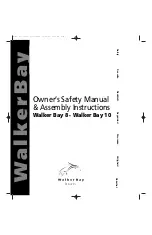
OWNER’S MANUAL
A1010 3 Cabin Segue 110V Original Dated Sept 2006.doc
Page 22 of 59
7.5 CARBON MONOXIDE
Carbon monoxide can accumulate in interior spaces and exterior areas. Carbon
monoxide accumulation is affected by a multitude of variables (e.g., boat geometry,
hatch, window and door openings, ventilation openings, proximity to other structures,
swim platforms, canvas enclosures, location of exhaust outlets, vessel attitude, wind
direction, boat speed, boat system maintenance, etc.)
DEFINITIONS
Carbon Monoxide – A gas formed by the combination of one atom of carbon and one
atom of oxygen. Chemists refer to it as CO for its chemical formula, C for carbon and
O for oxygen.
COHb (carboxyhemoglobin) – The molecule formed when CO, instead of oxygen,
combines with blood.
Enclosed Accommodation Compartment – One contiguous space that contains the
following:
a. designated sleeping accommodations,
b. a galley area with sink; and
c. a head compartment.
NOTE: A locker intended for gear storage and open passenger cockpits, with or
without canvas enclosures, are not considered to be enclosed accommodation
compartment(s).
PPM – Parts per million
PROPERTIES AND CHARACTERISTICS OF CARBON MONOXIDE
Carbon monoxide (CO) is a colourless, odourless and tasteless gas that weighs
about the same as air. It cannot be expected to rise or fall like some other gases
because it will distribute itself throughout the space. Do not rely on the sense of smell
or sight of other gases to detect CO as it diffuses in the air much more rapidly than
easily detectible vapours, (i.e., visible and aromatic vapours).
WHAT MAKES CARBON MONOXIDE
Carbon monoxide is produced any time material containing carbon burns, such as
gasoline, natural gas, oil, propane, coal or wood. Common sources of CO are
internal combustion engines and open flame appliances such as
•
Cooking
ranges
•
Central heating plants
•
Space
heaters
•
Water
heaters
•
Fireplaces,
and
•
Charcoal
grills
The carbon monoxide component of diesel exhaust is extremely low relative to the
carbon monoxide level found in gasoline engine exhaust.
Summary of Contents for LePard 46
Page 60: ......
Page 61: ......
Page 62: ......
Page 63: ......
Page 64: ......
Page 65: ......
Page 66: ......
Page 67: ......
Page 68: ......
Page 69: ......
Page 70: ......
Page 71: ......
Page 72: ......
Page 73: ......
Page 74: ......
Page 75: ......
Page 76: ......
Page 77: ......
Page 78: ......
Page 79: ......
Page 80: ......
Page 81: ......
Page 82: ......
Page 83: ......
Page 84: ......
Page 85: ......
Page 86: ......
Page 87: ......
Page 88: ......
Page 89: ......
Page 90: ......
Page 91: ......
Page 92: ......
Page 93: ......
Page 94: ......
Page 95: ......
Page 96: ......
Page 97: ......
Page 98: ......
Page 99: ......
Page 100: ......
















































